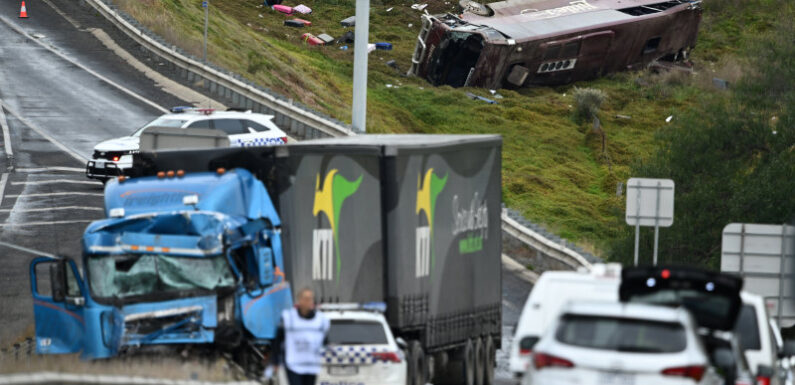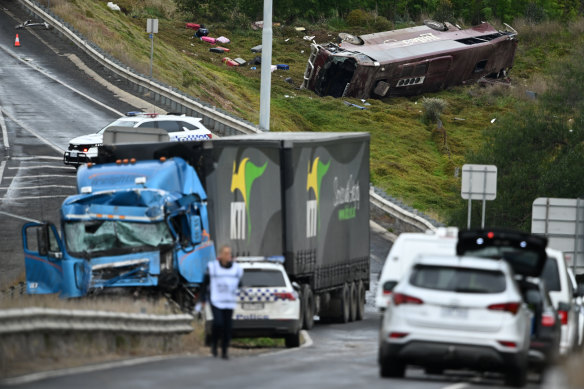
Save articles for later
Add articles to your saved list and come back to them any time.
Transport engineers say VicRoads is blocking access to safety information they need to identify crash black spots and fix dangerous roads contributing to collisions, injuries and deaths.
The Institute of Transportation Engineers Australia and New Zealand said its members at private engineering and road safety firms can no longer use police reports and sketches to examine what is causing crashes on Victorian roads since losing access to a database in 2015.
A badly damaged truck and bus after a crash in Bacchus Marsh in September last year. Credit: AAP
Instead, engineers have been relying on a public VicRoads database that is riddled with errors and four years out of date, which risks “wrong conclusions being drawn and ineffective treatments being built”, the professional association said.
The claim that road safety professionals’ work is being hampered coincides with a sharp jump in road deaths in Victoria, with the first half of this year the deadliest since 2011. As of Sunday night, 167 people had died on the state’s roads – 35 more than the average for that period over the previous five years.
Experts recently questioned whether Victoria’s road safety strategy had failed, with some calling out the state’s failure to collect and publish detailed crash and injury data.
The Institute of Transportation Engineers has been lobbying the state government for the past three years to reverse its decision to block private engineering consultants’ access to “restricted” crash data, which includes injury records and police reports and sketches.
The Department of Transport said the decision was due to privacy concerns, because the reports contain names and vehicle registration numbers. But the institute said that could be handled by having professionals sign confidentiality agreements.
A series of letters the group has sent to the government since 2020, obtained by this masthead, say the restricted crash information detailing drivers’ behaviour, which lane they were in and their direction of travel was essential for understanding and addressing safety risks.
“Without access to the restricted information, it is impossible to establish likely crash causes and develop effective solutions,” the group said in an April 2021 letter to former road safety minister Ben Carroll.
While consultants are usually provided the data if they are engaged directly by the government or councils, the institute said that does not account for the work they do for clients in the private sector, such as property developers.
VicRoads’ publicly available CrashStats database is less detailed, has not been updated since 2019 and is incorrect “more often than not”, according to one transport consultant, whose views the institute conveyed in a letter to the Transport Department.
A study of the public data identified six instances of pedestrians being hit by vehicles at left-turn slip lanes in a five-year period, whereas analysis of police reports found there had actually been 42 crashes.
“It is generally only by studying the sketch and narrative that it is possible to pick up these errors,” the consultant said. “Without access to the sketch and narrative the research study would have been deeply flawed and would have resulted in incorrect conclusions.”
A Transport Department spokesperson said the state needed to protect individuals’ privacy and that it shared redacted data with engineers it directly engaged with, and researchers on a cases-by-case basis.
“We’re making sure the use of data and evaluation across our road network is used appropriately to drive down road trauma and save lives,” they said.
Robert Morgan, a road safety consultant with more than 40 years’ experience working in Victoria, agreed access to up-to-date and accurate crash data was essential for industry professionals.
“There’s either a pattern [of crashes] or it’s happening in a particular traffic lane or particular side of the intersection, and without that detailed information, you can come to the wrong conclusions about what the road safety problem is,” he said.
The institute said limiting the data to state and local governments also meant there was “no transparency or accountability” on decisions they make.
The government spokesperson said Victoria is developing a new strategy for handling road safety data as part of its road safety plan, including collection, management, analysis and dissemination.
The Morning Edition newsletter is our guide to the day’s most important and interesting stories, analysis and insights. Sign up here.
Most Viewed in National
From our partners
Source: Read Full Article
